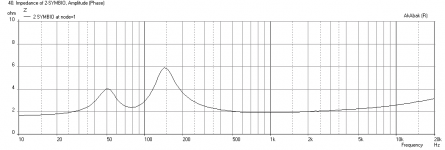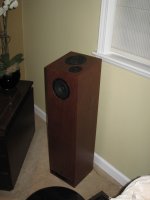I remember that in the mid 70's EPI had a design along the same lines as the 901 - called the 601 & 602, utilizing 2 rear firing sets of their 8" module, and 1 front firing set of the 6" module. Individually these modules proved quite competent over the full spectrum - certainly not requiring any EQ - and the models with multiples were pretty serious performance for the money.
Now something like the "castle" style micro-tower of DaveD's has worked out really well for me (3 pairs now), but as designed, it only incorporates 2 drivers.
No reason to abandon the project, I'm sure it'd be possible to get something quite interesting.
How much spacing are you envisioning between enclosure and rear wall?
Now that I've spent a bit more time surfing around those 10yrs old designs, I recall that when used front firing, the WR125 benefited from use of a small tweeter / first order high pass, so a small separate enclosure for the fronts couldn't hurt. The FR had better extension at the top.
Now something like the "castle" style micro-tower of DaveD's has worked out really well for me (3 pairs now), but as designed, it only incorporates 2 drivers.
No reason to abandon the project, I'm sure it'd be possible to get something quite interesting.
How much spacing are you envisioning between enclosure and rear wall?
Now that I've spent a bit more time surfing around those 10yrs old designs, I recall that when used front firing, the WR125 benefited from use of a small tweeter / first order high pass, so a small separate enclosure for the fronts couldn't hurt. The FR had better extension at the top.
Last edited:
I remember that in the mid 70's EPI had a design along the same lines as the 901 - called the 601 & 602, utilizing 2 rear firing sets of their 8" module, and 1 front firing set of the 6" module. Individually these modules proved quite competent over the full spectrum - certainly not requiring any EQ - and the models with multiples were pretty serious performance for the money.
Now something like the "castle" style micro-tower of DaveD's has worked out really well for me (3 pairs now), but as designed, it only incorporates 2 drivers.
How much spacing are you envisioning between enclosure and rear wall?
I'm really not sure on the spacing, that's something I would have to test and adjust in real-time once the speakers were built.
Thank you for your input!
Note that this is another way to implement a lower peak power handling 'FAST' alignment: http://community.fortunecity.ws/rive...d/dddllqd.html
I am going to have to try this. Looks really interesting. Certainly in Akabak, one can model as many different drivers in the same box as desired. (well up to node limit but that is easily 25 drivers). So the question is this meant just for a reflex box or can one do a sealed alignment with two different drivers? Wouldn't the one with the stronger motor want to push the weaker one like a passive radiator (kind of like power assisted brakes), albeit, an augmented passive radiator, so one could design it as a reflex PR without any ports.
One could try this on a very small scale at first with a paper cone Dayton RS100P-4 (fs=84Hz, Qts=0.54, Vas=2 liter) and a Tang Band W2-852SH (fs=180Hz, Qts=0.29, Vas=0.23 liter). Both 4 ohms so that may be a problem for my amp unless I switched to 2ohms PBTL.
The Dayton lacks thrilling highs, the Tang Band is like a dome tweeter in ability toplay 20kHz. If only they were 8 ohm drivers.
Modeling this can be fun though.
Now, I do have 16 ohm Faital Pro 3FE22's that are lower Qts...
Last edited:
I remember that in the mid 70's EPI had a design along the same lines as the 901 - called the 601 & 602, utilizing 2 rear firing sets of their 8" module, and 1 front firing set of the 6" module. Individually these modules proved quite competent over the full spectrum - certainly not requiring any EQ - and the models with multiples were pretty serious performance for the money.
Now something like the "castle" style micro-tower of DaveD's has worked out really well for me (3 pairs now), but as designed, it only incorporates 2 drivers.
No reason to abandon the project, I'm sure it'd be possible to get something quite interesting.
How much spacing are you envisioning between enclosure and rear wall?
Now that I've spent a bit more time surfing around those 10yrs old designs, I recall that when used front firing, the WR125 benefited from use of a small tweeter / first order high pass, so a small separate enclosure for the fronts couldn't hurt. The FR had better extension at the top.
I like the idea of a fullrange system no crossovers, WR125 not my first choice but its the only 16ohm fullrange I could find. I need to stick to 16ohm as I am only using 3 drivers and of course need to fall within the 4-8ohm range once wired up.
So not sure what to do at this point, was really stuck on the 3 fullrange driver design with 1 forward facing and 2 in the rear that's been floating around my head for 20 years.
My plan was to incorporate internal amps and an internal DAC so I could then use an android phone via USB GTG cable for input.
RS100P-4 & W2-852SH SYMBIO2 Enclosure
Here is simulation of the above two drivers in a 2.5 liter box with a 1.25in dia x 6in long duct. They seem to integrate well in a "FAST". Basically, enhanced sensitivity with the bass extension of the RS100P and the HF finesse of the W2-852. In the model, I don't see a downside.
Freq response:

Cone excursion:

Impedance:
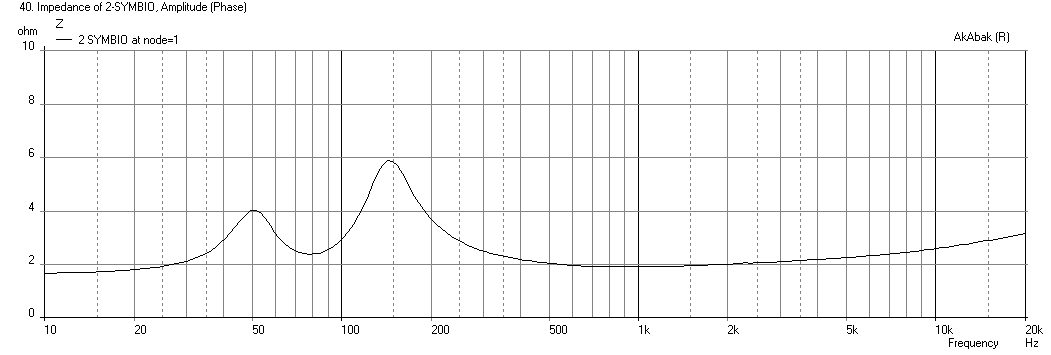
Impulse response:

This is without any diffraction, reflection, or baffle step considered. So in reality, maybe a 1mH 3R BSC circuit would flatten it all out.
So maybe take this to the next level and try something like a 5MR450NDY (95dB and Qts=0.55) and a Beta 8cx (93dB and Qts=0.29) in a common ported cabinet? Both drivers 8ohms so overall maybe 99dB at 2.83v?!
Here is simulation of the above two drivers in a 2.5 liter box with a 1.25in dia x 6in long duct. They seem to integrate well in a "FAST". Basically, enhanced sensitivity with the bass extension of the RS100P and the HF finesse of the W2-852. In the model, I don't see a downside.
Freq response:

Cone excursion:

Impedance:

Impulse response:

This is without any diffraction, reflection, or baffle step considered. So in reality, maybe a 1mH 3R BSC circuit would flatten it all out.
So maybe take this to the next level and try something like a 5MR450NDY (95dB and Qts=0.55) and a Beta 8cx (93dB and Qts=0.29) in a common ported cabinet? Both drivers 8ohms so overall maybe 99dB at 2.83v?!
Attachments
Last edited:
IIRC, Thorsten used either AkAbak or AJhorn to do his. Anyway, Altec/Japan did a studio monitor back in the '80s with a strange looking two stage mids/HF horn system, wide range 12" horn driver, 15" medium Q woofer in a fairly compact vented alignment with a ~96 dB/W eff./75 W power rating, so a wide Q gap such as Thorsten used is desirable.
Hmm, mathematically, the eff. gain is 10*LOG10(10^(95/10)+10^(93/10)) = ~97.12 dB
Thorsten's somewhat higher posted efficiency than the math predicted was up in the driver's break-up modes BW. If you look at his measurement, it's right at the 99.76 dB calculation in the driver's pistonic BW, which is the one that matters.
GM
Hmm, mathematically, the eff. gain is 10*LOG10(10^(95/10)+10^(93/10)) = ~97.12 dB
Thorsten's somewhat higher posted efficiency than the math predicted was up in the driver's break-up modes BW. If you look at his measurement, it's right at the 99.76 dB calculation in the driver's pistonic BW, which is the one that matters.
GM
I remember that in the mid 70's EPI had a design along the same lines as the 901 - called the 601 & 602, utilizing 2 rear firing sets of their 8" module, and 1 front firing set of the 6" module.
the WR125 benefited from use of a small tweeter / first order high pass
You sure? B0s3 used these numbers along with more in the series on some rather strange layouts.
Yeah, CSS came out with the 'FR' version to correct its shortcomings. Here's Adire Audio's solution, seems hard to believe over a decade has past and can only find a once great DIY provider in the net archive: https://web.archive.org/web/20051107231239/http://www.adireaudio.com/Files/WR125S-TM025F1Design.pdf
GM
I'm really not sure on the spacing, that's something I would have to test and adjust in real-time once the speakers were built.
Hmm, this is the wrong way to do any kind of speaker design, or most anything else for that matter. You set the performance goals, which includes the room location, listening position, etc., for speaker designs and since you want to do reflective bipoles, the room's acoustics dominates even more than normal, which is already a lot down below ~200-300 Hz.
This was the problem with the 901, it only worked optimally when properly set up, but it was an unrealistic layout for most folks, so those that kept them usually turned them around and fired them into the corners or placed them up against a wall at whatever angle sounded best overall, so something to consider. Search Roy Allison for more ideas.
GM
You sure? B0s3 used these numbers along with more in the series on some rather strange layouts.
HUMAN Speakers: EPI 601 information
HUMAN Speakers: EPI 602 information
And no stranger to interesting layouts themselves, these I never heard
http://www.humanspeakers.com/e/epicure-3.0.htm
yup, that's a long and very sad story - could make for an interesting mini-series - DaveD could fill you inYeah, CSS came out with the 'FR' version to correct its shortcomings. Here's Adire Audio's solution, seems hard to believe over a decade has past and can only find a once great DIY provider in the net archive: https://web.archive.org/web/20051107231239/http://www.adireaudio.com/Files/WR125S-TM025F1Design.pdf
GM
Last edited:
Here is a FE206EN and Beta 15A together in a 10 cu ft box with a 16in wide baffle and a huge (8in dia x 5in long) vent on the bottom. Vent has several layers of porous material to be a resistive vent. Box is tuned to 55Hz and there is a 1mH & 2.5ohm &5.6uF (all in prallel) shelfving and upper boost filter in place. Anyhow, I can get this 97dB sensitive speaker that has -3dB at 55Hz and pretty flat above. I still need some work to figure what bass driver I need to use to reach 30Hz at 95+dB? Probably can't be done as that is a lot of air to move.
It's kind of interesting though and a lot of fun to play with mix and match to get such a wide bandwidth and sensitive speaker. The impulse response and group delay are not too shabby either considering its a reflex box. This is with reflections and diffraction turned on, speaker is in 4pi space and baffles step loss is accounted for. The FE206EN was physically set-back by 1.1 inch (behind Beta 15A) in order to get the phase to align to prevent a cancellation dip at the 'X" frequency of 950Hz.
Predicted frequency response:
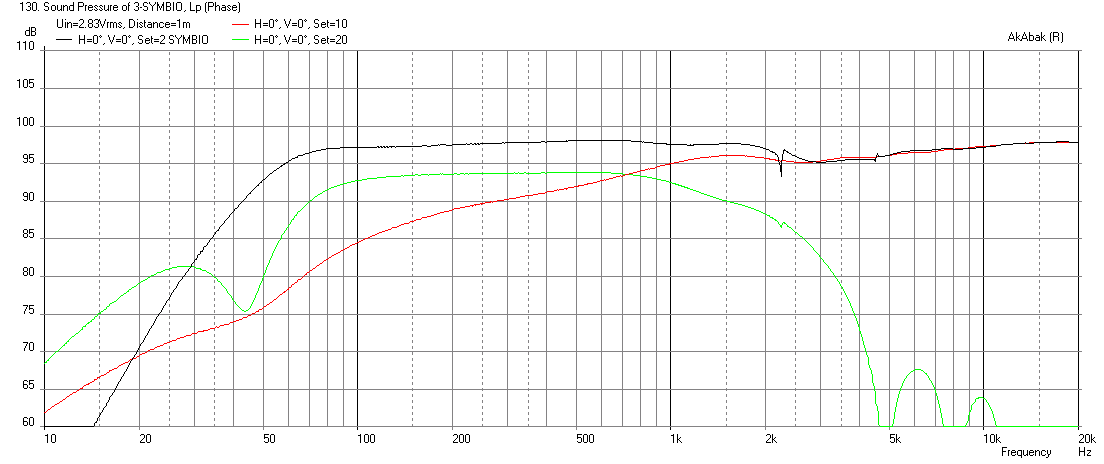
Predicted Impulse response:

Predicted Group delay:

Cone displacement:

System Impedance:

Electrical Power Input:

Anytime one can get a 55Hz f3 and 97dB sensitive speaker that uses less than 2 watts, you are doing real good. Perfect for flea amps, headphone amps, etc.
It's kind of interesting though and a lot of fun to play with mix and match to get such a wide bandwidth and sensitive speaker. The impulse response and group delay are not too shabby either considering its a reflex box. This is with reflections and diffraction turned on, speaker is in 4pi space and baffles step loss is accounted for. The FE206EN was physically set-back by 1.1 inch (behind Beta 15A) in order to get the phase to align to prevent a cancellation dip at the 'X" frequency of 950Hz.
Predicted frequency response:

Predicted Impulse response:

Predicted Group delay:

Cone displacement:

System Impedance:

Electrical Power Input:

Anytime one can get a 55Hz f3 and 97dB sensitive speaker that uses less than 2 watts, you are doing real good. Perfect for flea amps, headphone amps, etc.
Attachments
-
 Symbio3-FE206EN-Beta15A-Electrical-Power.png11 KB · Views: 105
Symbio3-FE206EN-Beta15A-Electrical-Power.png11 KB · Views: 105 -
 Symbio3-FE206EN-Beta15A-Impedance.png8.2 KB · Views: 107
Symbio3-FE206EN-Beta15A-Impedance.png8.2 KB · Views: 107 -
 Symbio3-FE206EN-Beta15A-Displ.png9.2 KB · Views: 103
Symbio3-FE206EN-Beta15A-Displ.png9.2 KB · Views: 103 -
 Symbio3-FE206EN-Beta15A-GD.png9 KB · Views: 107
Symbio3-FE206EN-Beta15A-GD.png9 KB · Views: 107 -
 Symbio3-FE206EN-Beta15A-IR.png6.5 KB · Views: 112
Symbio3-FE206EN-Beta15A-IR.png6.5 KB · Views: 112 -
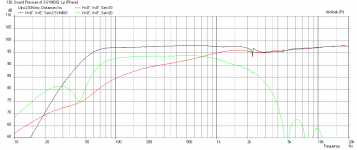 Symbio3-FE206EN-Beta15A-freq.png34 KB · Views: 107
Symbio3-FE206EN-Beta15A-freq.png34 KB · Views: 107
Last edited:
With identical drivers, you shouldn't need isolation, but I'd be tempted to isolate each driver anyway, so you have the option of low pass filtering the rear facing drivers.
Below 400HZ - 1kHZ the rear drivers will add a nice ambiance. Above about 1kHZ, you'll get better stereo effect imaging if the rear drivers are rolled off. Baffle step response is often a big deal with speakers that aren't against a wall, so I would make some measurements to see about that, and roll off the rear drivers at a frequency that would help that be less of a problem. That would be dependent on the baffle size and proximity to any room boundaries. Also, speakers that emit out the back will sound significantly better if they are at least 3 ft out from the wall behind them (psycho-acoustic effect).
Below 400HZ - 1kHZ the rear drivers will add a nice ambiance. Above about 1kHZ, you'll get better stereo effect imaging if the rear drivers are rolled off. Baffle step response is often a big deal with speakers that aren't against a wall, so I would make some measurements to see about that, and roll off the rear drivers at a frequency that would help that be less of a problem. That would be dependent on the baffle size and proximity to any room boundaries. Also, speakers that emit out the back will sound significantly better if they are at least 3 ft out from the wall behind them (psycho-acoustic effect).
FWIW, of the numerous multiple FR driver systems I've built over the past dozen or so years, those with "true" bipole configuration have been more troublesome with placement in relation to rear / side walls than designs such as the BD Pipes, or Castle Microtowers
BD-Pipes
Back to the OP's application, any particular reason you're fixated on 3 drivers?
BD-Pipes
Back to the OP's application, any particular reason you're fixated on 3 drivers?
Attachments
FWIW, of the numerous multiple FR driver systems I've built over the past dozen or so years, those with "true" bipole configuration have been more troublesome with placement in relation to rear / side walls than designs such as the BD Pipes, or Castle Microtowers
BD-Pipes
Back to the OP's application, any particular reason you're fixated on 3 drivers?
I've moved on, thank you all for your input - I may visit this again but for now I have discovered BMR drivers!
I read the post from Derek@Overkill but unfortunately am unable to attain the same drivers.
I would like to build a 2-way speaker using multiples of TEBM46C20N-4B BMR 3" Full Range and a MiniDSP for xover, I chose the miniDSP so I can use my own DAC as well.
X over @ 600HZ
And 1 or 2 Usher 8945A 7" Carbon Fiber/Paper Woofer's
I would like to build a pair of speakers as an upgrade to my Polk 7's
My polks are Vertically Biamped using two HK3490 receivers and I use a Tubedac 11 as a DAC/preamp, gotta love Kijiji
I want a big sound, was thinking 12 or more of the BMR's
Basically at this point would like some input on my driver and cutt-off choice.
-Cory
Last edited:
Hey! Those Polk 7 look like 3 way speaker system...but, hey, that midrange's too big...mmmhhh let's see VINTAGE: Polk Monitor 7 Speakers ? drewtensils yes, that's a passive.
What about going with a real 3 way speaker system ?!?
What about going with a real 3 way speaker system ?!?
Hey! Those Polk 7 look like 3 way speaker system...but, hey, that midrange's too big...mmmhhh let's see VINTAGE: Polk Monitor 7 Speakers ? drewtensils yes, that's a passive.
What about going with a real 3 way speaker system ?!?
RTiA7's are 3 way, not sure what that has to do with building a 2 way that ups the game on my polks.
Reading great things about BMR's and I like the idea of an array.
I would rather build an array with 4.5 BMR's and a sub but the 3 inch cant reach low enough at high volumes for adding a sub?
Why not a 2 way with 12 or more 3 inch BMR's down to 600hz?
thank-you for your input it is appreciated
oh, maybe those old Polks that I saw are better than the new floorstanding ones
Me, I don't like the array-idea. Same for double-woofers.
For classic 3-way I mean single woofer ( max 6.5" diameter ), a midrange and a tweeter.
The new Polk ( and, Hey!! that's where I took inspiration for my latest build: thanks to
remind me ) little bookshelf resembles what I aim for...
LSiM703 - Polk Audio
( I stretched the format and gone with 4"-2"-Dayton mini-8 )
Me, I don't like the array-idea. Same for double-woofers.
For classic 3-way I mean single woofer ( max 6.5" diameter ), a midrange and a tweeter.
The new Polk ( and, Hey!! that's where I took inspiration for my latest build: thanks to
remind me ) little bookshelf resembles what I aim for...
LSiM703 - Polk Audio
( I stretched the format and gone with 4"-2"-Dayton mini-8 )
Last edited:
I've moved on, thank you all for your input - I may visit this again but for now I have discovered BMR drivers!
You’re welcome, but seems like this new design should be in a thread of its own…………
GM
Codasm - as Bob notes, the miniDSP is analog in/out, and has had some comments here regarding the quality of on-board DACs. If you want to use one of their products that permits external DACs, I think you need to look a the nanoDIGI - (available in kit or assembled in cute little white box
In fact, I think Mr Brines has spoken of that himself. Be aware that the nano requires a stereo DAC for each speaker pass band you want to actively power - so a 3-way can start to get spendy if you have a taste for fancy DACs.
In fact, I think Mr Brines has spoken of that himself. Be aware that the nano requires a stereo DAC for each speaker pass band you want to actively power - so a 3-way can start to get spendy if you have a taste for fancy DACs.
- Status
- This old topic is closed. If you want to reopen this topic, contact a moderator using the "Report Post" button.
- Home
- Loudspeakers
- Full Range
- Question on building a 3 driver Enclosure


